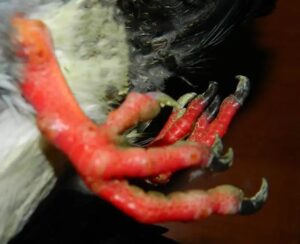Here’s how to check if your pigeon has mites or scaly leg & what Ivermectin treatments are available:
- Legs: Look for raised, thickened, and scaly skin on the legs and feet. The scales may be white, grey, or brown and can appear crusty or flaky. In severe cases, the legs may become deformed or swollen.
- Beak and face: In some cases, mites can also affect the beak and face, causing similar scaly lesions.
- Feathers: Check for feather loss or ruffled feathers, which can be a sign of irritation caused by mites.

Behaviour:
- Restlessness and scratching: Mites can cause itching and discomfort, leading the pigeon to scratch excessively. You may also notice the pigeon limping or holding one leg up due to pain.
- Stomping feet: Some pigeons will stomp their feet at night when the mites are most active.
Additional checks:
- Shine a flashlight on the legs at night: Mites are most active in the dark, so you may be able to see them moving around on the skin.
- Examine the cage and nesting area: Look for tiny red or black spots, which could be mite droppings.
If you suspect your pigeon has mites or scaly leg, it’s important to consult a veterinarian for diagnosis and treatment. Early diagnosis and treatment are important to prevent complications and ensure the pigeon’s health.
Here are some additional tips:
- Do not attempt to treat your pigeon yourself without veterinary advice. Some over-the-counter mite treatments can be harmful to pigeons.
- Quarantine any infected pigeons to prevent the spread of mites to other birds.
- Clean and disinfect the pigeon’s cage and nesting area thoroughly. This will help to kill any remaining mites.
- Provide your pigeon with a healthy diet and plenty of fresh water. This will help to boost its immune system and fight off infection.
While Ivermectin can be effective in treating mites and scaly leg in pigeons, you should understand the treatment planning before attempting any medication, furthermore using Ivermectin incorrectly can be prolong the condition in your pigeon.
Here’s what you need to know about using Ivermectin for pigeons:
Types of Ivermectin:
- Oral: Can be added to drinking water or administered directly.
- Spot-on: Applied directly to the back of the neck.
- Injection: Administered by a veterinarian.
Dosage and frequency:
- Dosage and frequency vary depending on the type of Ivermectin, also the severity of the infestation, and the pigeon’s size and health. Never rely on internet sources or guesstimate the dosage, furthermore follow the instructions provided.
- Typical treatment intervals involve repeated doses over several weeks.
Safety:
- Ivermectin can interact with other medications, so inform your veterinarian about any other treatments your pigeon is receiving.
Additional notes:
- Ivermectin is only effective against the mites themselves, not their eggs. Therefore, multiple treatments may be necessary to break the mite lifecycle.
- Combining Ivermectin with other mite control measures, such as cleaning the cage and nesting area, is crucial for complete eradication.
Remember:
- Self-medicate your pigeon based on information provided with the treatment from the manufacturer, Naqua or advice veterinary sources.
- Follow instructions carefully and complete the entire treatment course even if symptoms seem to improve before the recommended timeframe.
By prioritizing guidance and using Ivermectin, you can help your pigeon recover from mites and scaly leg effectively.
Types of Ivermectin Treatments
| Feature | Harkers Harkamectin Spot-on | AviSolve Oral | AviSolve Spot-on | Easimec Spot-on |
| Application | Spot-on | Oral | Spot-on | Spot-on |
| Target parasites | Mites, lice, worms | Mites, lice, worms | Mites, lice | Mites, lice |
| Withdrawal period | 7 days | 7 days | 7 days | 7 days |
| Ease of use | Easy | Moderate | Easy | Easy |
Here’s a more detailed breakdown of each product:
Harkers Harkamectin Spot-on:
- This is a potent spot-on treatment that is effective against a wide range of parasites, including mites, lice, and worms.
- It is easy to use, with just two drops applied to the back of the neck.
AviSolve Oral: Click Here To Buy
- This is a unique oral treatment by Naqua that can be added to drinking water and administered directly to the bird. It can also be used as a topical bath treatment.
- It is effective against mites, lice, and worms.
AviSolve Spot-on: Click Here To Buy
- This is another ivermectin spot-on treatment that is effective against mites and lice & scaley leg.
Easimec Spot-on:
- It is effective against mites and lice, but not against worms.
- It is easy to use, with just one drop applied to the back of the neck.
Which product is right for your pigeon?
The best product for your pigeon will depend on a number of factors, including the type of parasites you are trying to control, your budget, and also your bird’s health and temperament.
Here are some additional things to keep in mind:
- It is important to follow the dosage instructions carefully and never give your pigeon more than the recommended amount.
- Ivermectin is not effective against all types of parasites, moreover if you are unsure what type of parasite your pigeon has, it is important to have them diagnosed by a veterinarian.
- Ivermectin should not be used in pregnant or nursing pigeons.
Disclaimer. Easimec® is a registered trademark of Hyperdrug Ltd. The composer of this article and the owner of this website is not affiliated with Easimec or Hyperdrug Ltd. The article if for information only showing comparisons between available treatments for pigeons.




